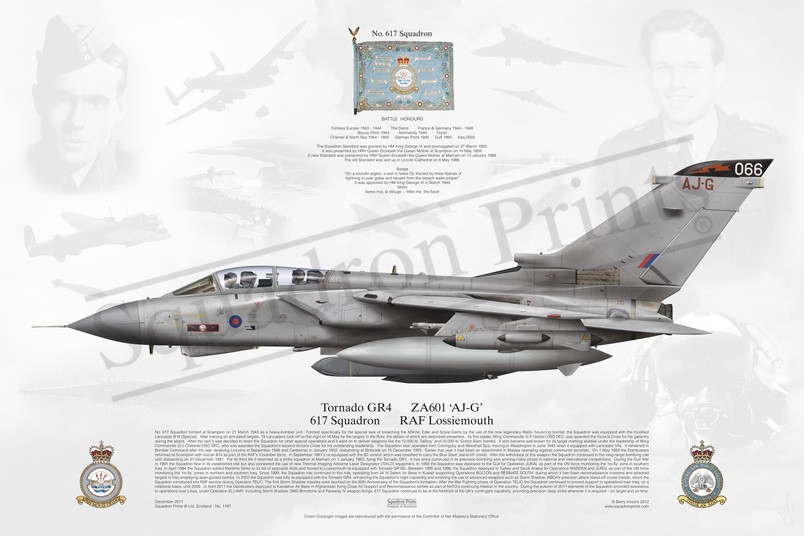#1167 Tornado GR4

Purchased products will not feature the Squadron Prints watermark
Description
Squadron Prints Lithograph No. 1167 - Tornado GR4, ZA601 \'AJ-G\', 617 Squadron, RAF Lossiemouth.
No. 617 Squadron formed at Scampton on 21 March 1943 as a heavy-bomber unit. Formed specifically for the special task of breaching the Möhne, Eder and Sorpe Dams by the use of the now legendary Wallis ‘bouncing bombs’ the Squadron was equipped with the modified Lancaster B III (Special). After training on simulated targets, 19 Lancasters took off on the night of 16 May for the targets in the Ruhr, the details of which are described elsewhere. Its first leader, Wing Commander G P Gibson DSO DFC, was awarded the Victoria Cross for his gallantry during the attack. After the raid it was decided to retain the Squadron for other special operations and it went on to deliver weapons like the 12,000 lb ‘Tallboy’ and 22,000 lb ‘Grand Slam’ bombs. It also became well known for its target marking abilities under the leadership of Wing Commander G L Cheshire DSO DFC, who was awarded the Squadron’s second Victoria Cross for his outstanding leadership. The Squadron later operated from Coningsby and Woodhall Spa, moving to Waddington in June 1945 when it equipped with Lancaster VIIs. It remained in Bomber Command after the war, receiving Lincolns in September 1946 and Canberras in January 1952, disbanding at Binbrook on 15 December 1955. Earlier that year it had been on detachment in Malaya operating against communist terrorists. On 1 May 1958 the Dambusters reformed at Scampton with Vulcan B1s as part of the RAF’s V-bomber force. In September 1961 it re-equipped with the B2 version which was modified to carry the Blue Steel ‘stand-off’ bomb. After the withdrawal of this weapon the Squadron continued in the long-range bombing role until disbanding on 31 December 1981. For its third life it reformed as a strike squadron at Marham on 1 January 1983, flying the Tornado GR1. It has since continued in its precision bombing vein winning many prizes in national and international competitions. During the Gulf War in 1991 the Squadron flew in its established role but also pioneered the use of new Thermal Imaging Airborne Laser Designator (TIALD) equipment. In 1992 the Squadron was deployed to the Gulf for Operation JURAL as part of the UN force monitoring the ‘no-fly’ zone in southern Iraq. In April 1994 the Squadron added Maritime Strike to its list of specialist skills and moved to Lossiemouth re-equipped with Tornado GR1Bs. Between 1995 and 1998, the Squadron deployed to Turkey and Saudi Arabia for Operations WARDEN and JURAL as part of the UN force monitoring the ‘no-fly’ zones in northern and southern Iraq. Since 1999, the Squadron has continued in this role, operating from Ali Al Salem Air Base in Kuwait supporting Operations BOLTON and RESINATE SOUTH, during which it has flown reconnaissance missions and attacked targets in Iraq employing laser-guided bombs. In 2002 the Squadron was fully re-equipped with the Tornado GR4, enhancing the Squadron’s night capability and enabling the use of advanced weapons such as Storm Shadow, MBDA’s precision attack stand-off cruise missile, which the Squadron introduced into RAF service during Operaton TELIC. The first Storm Shadow missiles were lauched on the 60th Anniversary of the Squadron’s formation. After the War Fighting phase of Operation TELIC the Squadron continued to proved support to operations over Iraq, on a rotational basis, until 2009. In April 2011 the Dambusters deployed to Kandahar Air Base in Afghanistan flying Close Air Support and Reconnaissance sorties as part of NATO’s continuing mission in the country. During the autumn of 2011 elements of the Squadron provided assistance to operations over Libya, under Operation ELLAMY, including Storm Shadow, DMS Brimstone and Paveway IV weapon firings. 617 Squadron continues to be at the forefront of the UK’s contingent capability, providing precision deep strike wherever it is required – on target and on time.
You may also like
-
Signed Atlantic Flyers Print
84 Sqn; 78 SqnRAF Akrotiri; RAF Benson; RAF Lossiemouth
